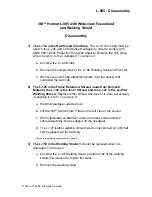
C-1
Rev 2.2, 10/31/94
C. MIDI Implementation Notes
This appendix describes the MIDI implementation of the 601. If you are a newcomer to MIDI,
you would do well to familiarize yourself with MIDI and its usage by reading one of the many
introductory-level books available at booksellers.
C.1 Overview
There are two MIDI messages of importance to the 601: MIDI Control Change and MIDI Sysex.
The standard MIDI implementation table may be found in Appendix G.
The 601 responds to MIDI messages containing its unique device type and unit number as well
as MIDI messages matching only its device type (provided that Omni mode has been turned on).
MIDI Control Change messages affect volume, panning, bank select, and omni mode. MIDI
Program Change commands change user programs (in conjunction with the Bank Select
command). All other 601 program changes (set/get program data, identify request) occur via
MIDI sysex messages.
An identification scheme allows a daisy chain of 601's to share a MIDI bus. Sending an
identification request to the first unit in the chain causes all units to report their current MIDI
channel and unit number, along with the identifying string, "SYMETRIX 601". The responses
are in the same order as the arrangement of units along the MIDI daisy chain.
In the following tables, all numbers are written in the base (decimal or hexadecimal) listed at
the head of each table. Where necessary for clarity, hexadecimal numbers are followed with 'h',
and decimal numbers are followed with 'd'). Type refers to the length of the request or response.
C.1.1 Control Change (B
n)
The control change message commands all
devices sharing a given MIDI channel to
change one of the following parameters.
Typically, only like devices share the same
MIDI channel.
C.1.1.1 Example
Command the 601 to set the output
panning to center.
Send (hex):
<MIDI command><nnnn><data>< data>
B
n
0A 40
where:
n
is the MIDI channel number (0-F), encoded in hex
C.1.2 Realtime MIDI
There are two Realtime MIDI setups available per program. Each setup allows some predefined
MIDI action to control any one parameter on the 601. An offset and scale factor (multiplier)
tailor the response. These are stored on a per-program basis and can be edited through MIDI
sysex or through the realtime MIDI functions on the front-panel (see Chapter 7). Regardless of
the actual range of values required internally (to the 601), the externally accessed range of
values is mapped across the range of 0 to 127 (decimal). The parameter value can be scaled and
offset to shift the value into a useful range.
The range of the scale factor is plus or minus 4 and the Realtime Scaling Table maps the 0 to
127 range used in the edit buffer to the stored scale factor value. The Realtime Scaling Table
may be found later in this chapter.
For instance, to represent a scale factor (multiplier value) of 2.4, refer to the Realtime Scaling
Table, locate the value 2.4 within the table grid, and read the step number from the row and
Code
(dec)
Action
Value(dec)
7
Volume
(input/output)
0-127 (-64dB -
0dB attn)
10
L/R Pan
0: l
64: c
127 r:
32
Bank Select
0: RAM (1-128)
1: ROM (129-
256)
124
Omni Mode Off
0
125
Omni Mode On
0
Содержание 601
Страница 46: ...4 18 Rev 2 2 10 31 94 This page is blank believe it or not ...
Страница 48: ...4 20 Rev 2 2 10 31 94 Notes ...
Страница 50: ...5 2 Rev 2 2 10 31 94 Notes ...
Страница 70: ...7 16 Rev 2 2 10 31 94 Notes ...
Страница 72: ...8 2 Rev 2 2 10 31 94 Notes ...
Страница 74: ...9 2 Rev 2 2 10 31 94 Notes ...
Страница 78: ...11 2 Rev 2 2 10 31 94 Notes ...
Страница 126: ...D 12 Rev 2 2 10 31 94 Notes ...
Страница 138: ...G 8 Rev 2 2 10 31 94 Notes ...
















































